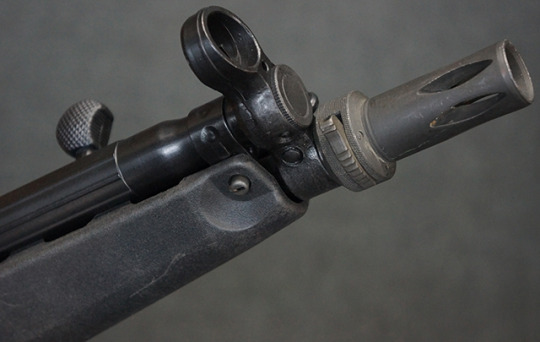#MP5A2
Photo

MP5k PDW Shirt Added to the Catalog... . ⭐CHAMBER CHECK CLOTHING⭐ DROPPING SOON! . #mp5 #mp5k #mp5kpdw #hk #hkmp5 #hkmp5k #hkmp5kpdw #hkmp5sd #mp5sd #hecklerandkoch #mp5monday #mp5a5 #mp5a3 #mp5a2 #hkmp5kn https://www.instagram.com/p/CXEkVvpF-rH/?igshid=NGJjMDIxMWI=
#mp5#mp5k#mp5kpdw#hk#hkmp5#hkmp5k#hkmp5kpdw#hkmp5sd#mp5sd#hecklerandkoch#mp5monday#mp5a5#mp5a3#mp5a2#hkmp5kn
0 notes
Photo

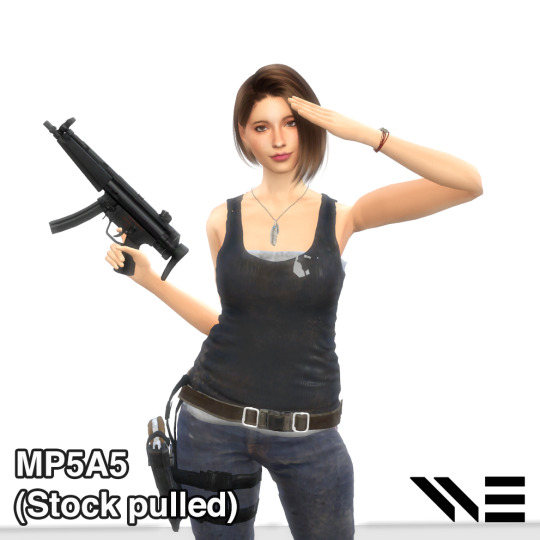
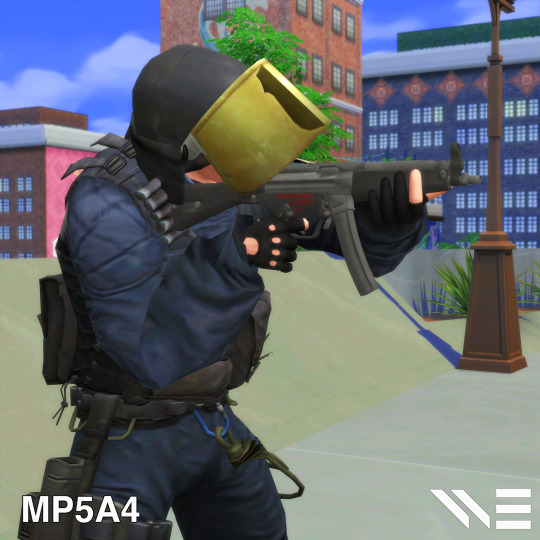
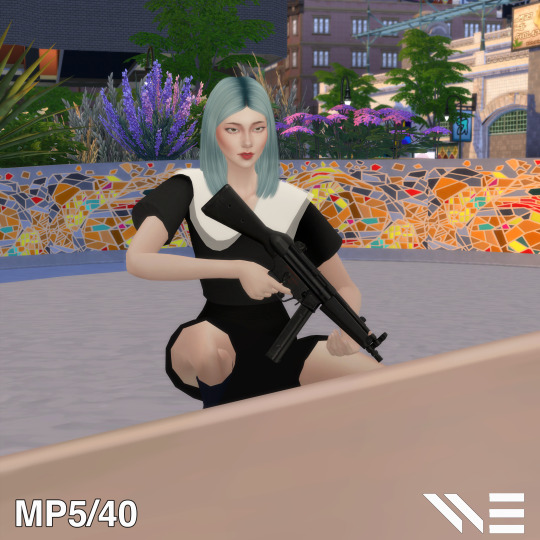
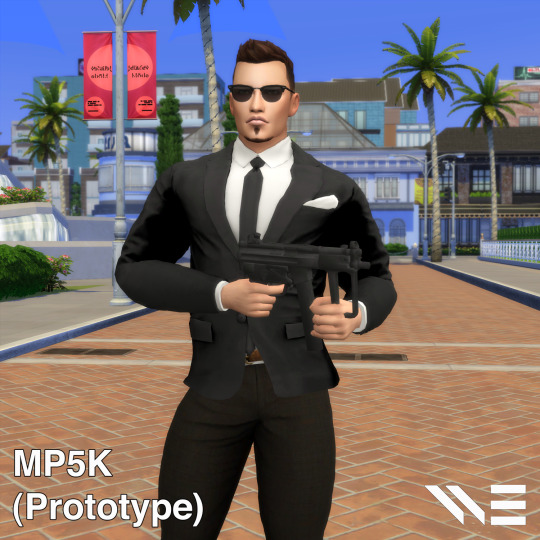
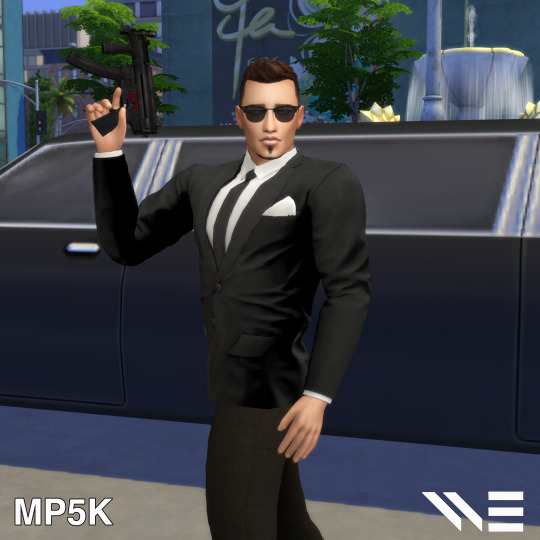
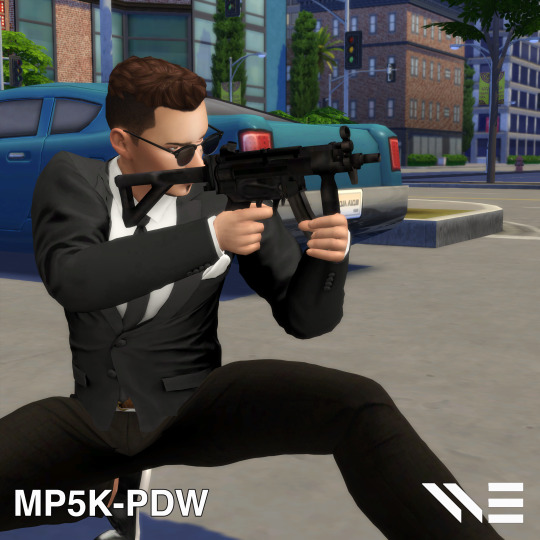

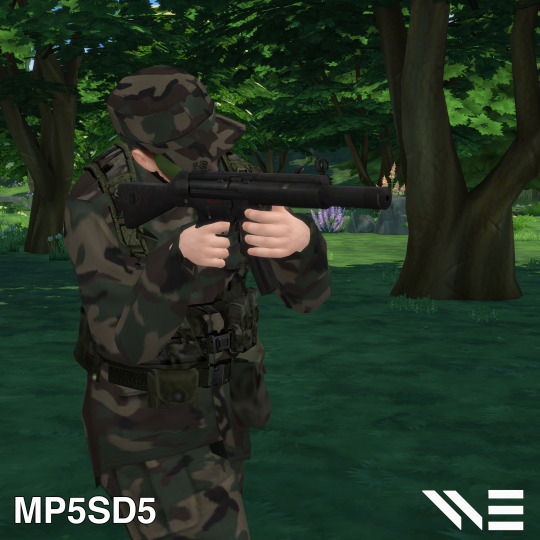
🇩🇪 German Maschinenpistole 5/ MP5 🇩🇪
Special Thanks To @mimoto-sims For Claire’s Outfit... Such A Magnificent Work :)
@ts4-poses @ts4-poses-masterlist
DOWNLOAD!!!!!
One of the masterpiece in the machine pistol's realm. It's known by it's simplicity, accuracy and relative reasonable price. Designed in H&K as a SMG variant of G3 Rifle and rolled out in 1966. Until today, it's still in the armory of 70 countries around the world, not including the militias which utilises this babies. And now we're gladly bring it tio The Sims 4 format
Variants:
1.Standard Model
H&K MP5A4 & MP5A5
The MP5A4 (fixed stock) and MP5A5 (sliding stock) models, which were introduced in 1974, are available with four-position trigger groups. The pistol grips are straight, lacking the contoured grip and thumb groove of the MP5A1, MP5A2, and MP5A3. The selector lever stops are marked with bullet pictograms rather than letters or numbers (each symbol represents the number of bullets that will be fired when the trigger is pulled and held rearward with a full magazine inserted in the weapon) and are fully ambidextrous (the selector lever is present on each side of the trigger housing). The additional setting of the fire selector, one place before the fully automatic setting, enables a two or three-shot burst firing mode. the A5 Model Got 2 Stage Of Stock (Retracted and Extended) For Extreme Realism
H&K MP5/10
In 1992, Heckler & Koch introduced the MP5/10 (chambered in 10mm Auto) .which are based on the MP5A4 and MP5A5. These weapons were assembled in fixed and retractable stock configurations (without a separate designation) and are fed from translucent 30-round polymer box magazines. These weapons include a bolt hold-open device, which captures the bolt group in its rear position after expending the last cartridge from the magazine. The bolt is then released by pressing a lever positioned on the left side of the receiver. Both weapons use a barrel with 6 right-hand grooves and a 380 mm (1:15 in) twist rate, and like the MP5-N, both have a 3-lugged muzzle device and a tritium-illuminated front sight aiming dot.
2.Sub Compact Model
H&K MP5K
In 1976, a shortened submachine gun version of the MP5A2 was introduced; the MP5K (K from the German word Kurz = "short") was designed for close quarters battle use by clandestine operations and special services. The MP5K does not have a shoulder stock (the receiver end was covered with a flat end cap, featuring a buffer on the inside and a sling loop on the outside), and the bolt and receiver were shortened at the rear. The resultant lighter bolt led to a higher rate of fire than the standard MP5. The barrel, cocking handle and its cover were shortened and a vertical foregrip was used to replace the standard handguard. The barrel ends at the base of the front sight, which prevents the use of any sort of muzzle device. In 1991, a further variant of the MP5K was developed, designated the MP5K-PDW (PDW—Personal Defense Weapon) that retained the compact dimensions of the MP5K but restored the fire handling characteristics of the full-size MP5A2. The MP5K-PDW uses a side-folding synthetic shoulder stock (made by the U.S. company Choate Machine and Tool), a "Navy" trigger group, a front sight post with a built-in tritium insert and a slightly lengthened threaded, three-lug barrel (analogous to the MP5-N). The stock can be removed and replaced with a receiver endplate; a rotary drum with apertures from the MP5A2 can also be used.
3.Sub Sonic Model
H&K MP5SD5 & H&K MP5SD6
In 1974, H&K initiated design work on a sound-suppressed variant of the MP5, designated the MP5SD (SD—Schalldämpfer, German for "sound suppressor"), which features an integral but detachable aluminium sound suppressor and a lightweight bolt. The weapon's 146 mm (5.7 in) barrel has 30 2.5 mm (0.1 in) ports drilled forward of the chamber through which escaping gases are diverted to the surrounding sealed tubular casing that is screwed onto threading on the barrel's external surface just prior to the ported segment. The suppressor itself is divided into two stages; the initial segment surrounding the ported barrel serves as an expansion chamber for the propellant gases, reducing gas pressure to slow down the acceleration of the projectile. The second, decompression stage occupies the remaining length of the suppressor tube and contains a stamped metal helix separator with several compartments which increase the gas volume and decrease its temperature, deflecting the gases as they exit the muzzle, so muffling the exit report. The bullet leaves the muzzle at subsonic velocity, so it does not generate a sonic shock wave in flight. As a result of reducing the barrel's length and venting propellant gases into the suppressor, the bullet's muzzle velocity was lowered anywhere from 16% to 26% (depending on the ammunition used) while maintaining the weapon's automation and reliability. The weapon was designed to be used with standard supersonic ammunition with the suppressor on at all times. The MP5SD is produced exclusively by H&K in several versions: the MP5SD1 and MP5SD4 (both have a receiver end cap instead of a buttstock), MP5SD2 and MP5SD5 (equipped with a fixed synthetic buttstock) and the MP5SD3 and MP5SD6 (fitted with a collapsible metal stock). The MP5SD1, MP5SD2 and MP5SD3 use a standard 'SEF' trigger group (from the MP5A2 and MP5A3), while the MP5SD4, MP5SD5, and MP5SD6 use the 'Navy' trigger group—a trigger module with a mechanically limited 3-round burst mode and ambidextrous selector controls (from the MP5A4 and MP5A5). A suppressed version was produced for the U.S. Navy—designated the MP5SD-N, which is a version of the MP5SD3 with a retractable metal stock, front sight post with tritium-illuminated dot and a stainless steel suppressor. This model has a modified cocking handle support to account for the slightly larger outside diameter of the suppressor. The design of the suppressor allows the weapon to be fired with water inside, should water enter the device during operation in or near water.
#TS4#ts4cc#ts4 cc#ts4 cc download#the sims 4 gun#the sims 4 weapon#ts4military#ts4weapon#ts4gun#the sims 4 military#sims 4#thesims4#sims4gun#the sims 4#the sims 4 cc#the sim#germany#submachine gun#west germany#heckler & koch#mp5#mp5k#the sims 4 custom content#the sims 4 accessories#the sims cc
55 notes
·
View notes
Note
(same asker) that's valid. You have a favorite? Either real life or just in games
Thank you for reading my ramble <3
Favorites, I have plenty. And by plenty like... probably a lot. Except shotguns, I'm not that big on shotguns. And revolvers.
I haven't played many games that depict fictional firearms so here are some of my favorite ones from real life.
Handgun: Kimber Custom TLE (a 1911-pattern handgun), I admit I grow a liking on this specific 1911 because of Modern Warfare 2019. Previously I've been a Glock guy, particularly the 9mm ones like 17, 18C and 19 (I have both 1911 and Glock toy guns).
Submachine gun: MP5, particularly MP5A2. This thing is more than 50 years old by now but not many firearms let you perform the HK slap.
Assault rifle: AR-15 pattern rifles for its ergonomics (I have an airsoft AR-15) and modularity, but then I'd be a liar if I don't like AKs as well, the ones chambered for 5.45mm. Plus some bullpups like IWI Tavor.
Precision rifle: Dragunov SVD, all time favorite precision rifle. Not the SVDM, but the original SVD with wood furniture.
0 notes
Photo
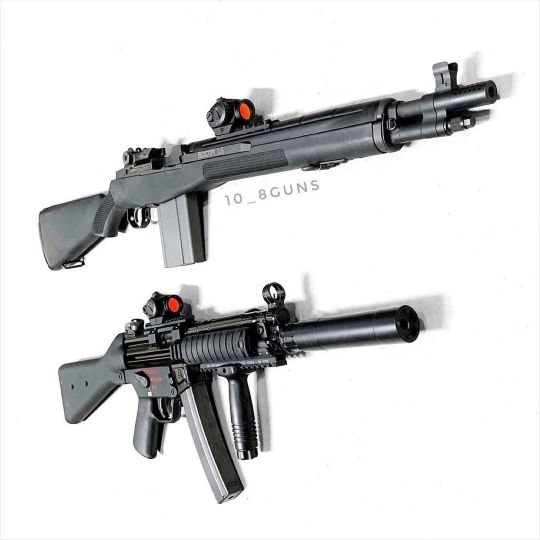
@10_8guns • SOCOM vibes. 💯 - Springfield M1A SOCOM 16 - MP5A2 KAC, Rugged Suppressors Obsidian K. - Vortex Crossfire II’s #m1a #socom #socom16 #springfieldarmory #mp5 #mp5a2 #kac #knightsarmament #silencer #suppressor #308 #battlerifle #navyseals #ruggedsuppressors #sbr #mp5 https://www.instagram.com/p/CP_z8FClWpt/?utm_medium=tumblr
#m1a#socom#socom16#springfieldarmory#mp5#mp5a2#kac#knightsarmament#silencer#suppressor#308#battlerifle#navyseals#ruggedsuppressors#sbr
69 notes
·
View notes
Photo
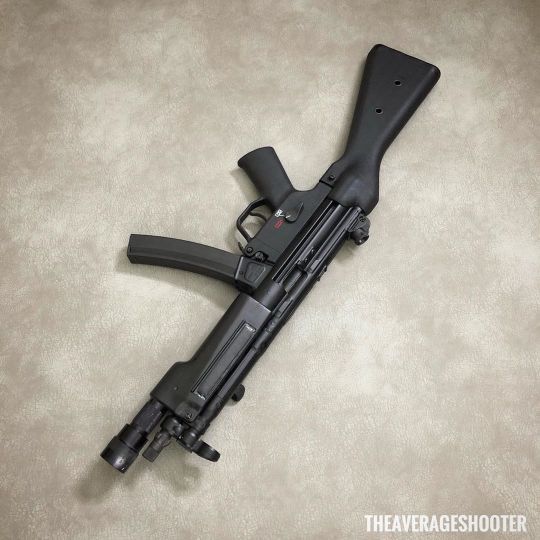
I kept pushing off getting a MP5 for years. After owning this for a couple, I wish I could go back in time to slap myself in the back of the head. Such a badass gun. . #mp5 #mp5a2 #sbr #nfa #zenith #z5rs #rollerlock #rollerlife #hk @weaponsdaily @weaponsfanatics @weaponspromo @gunsdaily @gunfanatics @gunfreaks @firearms @zenithfirearms @rollerlyfe @hk_rollerlock_addicts @guns_fanatics_ @guns.page @hkparts (at Fayetteville, North Carolina) https://www.instagram.com/p/B7BSAeGJpBa/?igshid=4oqwmp83p8qc
23 notes
·
View notes
Photo
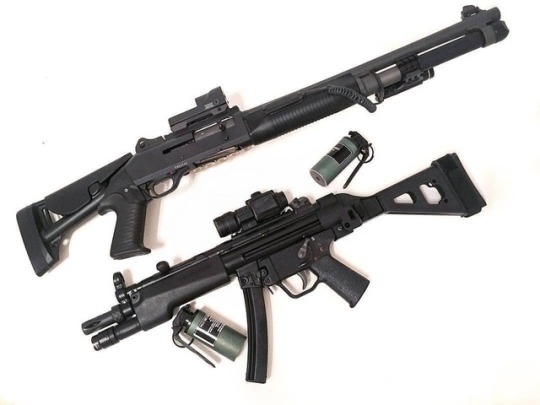
#Repost @essentialweaponslab 👈👊🔫 ・・・ Roger, Open Flash un Clear #rainbowsix #rainbow6 #mp5 #hecklerandkoch #hk #mp5a2 #mp5n #benelli #m4 #m1014 #classic #art #rollerlock #sexy #tomclancy #weaponsdaily #professionallyviolent #gunsofinstagram #ptrindustries #thepewpewlife #steelwaiting #operatoraf #guns #firearms #shooters #freedom #GunpornDistributors #AZWS #TwitterBound https://www.instagram.com/p/BurOExuhQV-/ https://www.instagram.com/p/BurOExuhQV-/?utm_source=ig_tumblr_share&igshid=9vptrhkijw0m
#repost#rainbowsix#rainbow6#mp5#hecklerandkoch#hk#mp5a2#mp5n#benelli#m4#m1014#classic#art#rollerlock#sexy#tomclancy#weaponsdaily#professionallyviolent#gunsofinstagram#ptrindustries#thepewpewlife#steelwaiting#operatoraf#guns#firearms#shooters#freedom#gunporndistributors#azws#twitterbound
18 notes
·
View notes
Photo
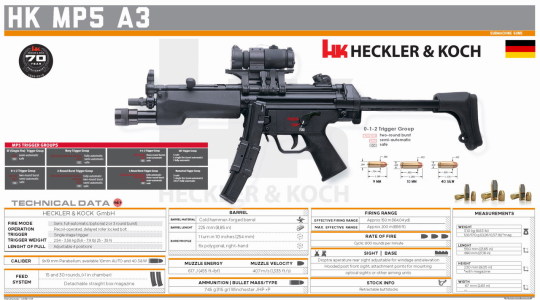
Heckler & Kock GmbH - HK MP5 A3
The MP5 (German: Maschinenpistole 5) is a 9x19mm Parabellum submachine gun, developed in the 1960s by a team of engineers from the German small arms manufacturer Heckler & Koch GmbH (H&K) of Oberndorf am Neckar. There are over 100 variants of the MP5, including some semi-automatic versions.
The MP5 is one of the most widely used submachine guns in the world, having been adopted by 40 nations and numerous military, law enforcement, intelligence, and security organizations. It was widely used by SWAT teams in North America, but has largely been supplanted by M16 variants in the 21st century.
In 1999, Heckler & Koch developed the Heckler & Koch UMP, the MP5's successor; both are available as of 2019. It however, was not met with the same level of success.
Heckler & Koch, encouraged by the success of the G3 automatic rifle, developed a family of small arms consisting of four types of firearms all based on a common G3 design layout and operating principle. The first type was chambered for 7.62×51mm NATO, the second for the 7.62×39mm M43 round, the third for the intermediate 5.56×45mm NATO caliber, and the fourth type for the 9×19mm Parabellum pistol cartridge. The MP5 was created within the fourth group of firearms and was initially known as the HK54.
Work on the MP5 began in 1964 and two years later it was adopted by the German Federal Police, border guard and army special forces, referring to as the "MP64" or later "MP5". The MP5A1 was introduced in the late '60s, which the first model to have the iconic ring front sight and the slimline handguard. In 1970, the MP5A2 and MP5A3 was introduced. The MP5A3 was actually used in the Vietnam War by the MACV-SOG as a limited service weapon and Thailand Forces. It also had its first film "The Millions Games" released on October 18, 1970. In 1974, the MP5SD was introduced, which is a suppressed variant of the MP5. In 1976, the MP5K was introduced as a request for a variant for South America. In 1977, the Standard Curved was introduced for the MP5A2 and MP5A3 design. In 1978, the Tropical forearm was introduced to be produced with the MP5.
In 1980, the MP5 achieved iconic status as a result of its use on live television by SAS commandos in Operation Nimrod, where they stormed the Iranian Embassy in London, rescuing hostages and killing five terrorists. The MP5 has become a mainstay of SWAT units of law enforcement agencies in the United States since then. However, in the late 1990s, as a result of the North Hollywood shootout, police special response teams have supplanted most MP5s with AR-15-based rifles.
The MP5 is manufactured under license in several nations including Greece (formerly at EBO – Hellenic Arms Industry, currently at ΕΑΣ – Hellenic Defense Systems), Iran (Defense Industries Organization), Mexico (SEDENA), Pakistan (Pakistan Ordnance Factories), Saudi Arabia, Sudan (Military Industry Corporation), Turkey (MKEK), and the United Kingdom (initially at Royal Ordnance, later diverted to Heckler & Koch Great Britain).
The primary version of the MP5 family is the MP5A2, which is a lightweight, air-cooled, selective fire delayed blowback operated 9×19mm Parabellum weapon with a roller-delayed bolt. It fires from a closed bolt (bolt forward) position.
The fixed, free floating, cold hammer-forged barrel has 6 right-hand grooves with a 1 in 250 mm (1:10 in) rifling twist rate and is pressed and pinned into the receiver.
The first MP5 models used a double-column straight box magazine, but since 1977, slightly curved, steel magazines are used with a 15-round capacity (weighing 0.12 kg) or a 30-round capacity (0.17 kg empty).
The adjustable iron sights (closed type) consist of a rotating rear diopter drum and a front post installed in a hooded ring. The rear sight is mechanically adjustable for both windage and elevation with the use of a special tool, being adjusted at the factory for firing at 25 metres (27 yd) with standard 8 grams (123 gr) FMJ 9×19mm NATO ammunition. The rear sight drum provides four apertures of varying diameters used to adjust the diopter system, according to the user's preference and tactical situation. Changing between apertures does not change the point of impact down range. For accurate shooting the user should select the smallest aperture that still allows an equal circle of light between the rear sight aperture and the outside of the front sight hood ring.
The MP5 has a hammer firing mechanism. The trigger group is housed inside an interchangeable polymer trigger module (with an integrated pistol grip) and equipped with a three-position fire mode selector that serves as the manual safety toggle. The "S" or Sicher position in white denotes weapon safe, "E" or Einzelfeuer in red represents single fire, and "F" or Feuerstoß (also marked in red) designates continuous fire. The SEF symbols appear on both sides of the plastic trigger group. The selector lever is actuated with the thumb of the shooting hand and is located only on the left side of the original SEF trigger group or on both sides of the ambidextrous trigger groups. The safety/selector is rotated into the various firing settings or safety position by depressing the tail end of the lever. Tactile clicks (stops) are present at each position to provide a positive stop and prevent inadvertent rotation. The "safe" setting disables the trigger by blocking the hammer release with a solid section of the safety axle located inside the trigger housing.
The non-reciprocating cocking handle is located above the handguard and protrudes from the cocking handle tube at approximately a 45° angle. This rigid control is attached to a tubular piece within the cocking lever housing called the cocking lever support, which in turn makes contact with the forward extension of the bolt group. It is not however connected to the bolt carrier and therefore cannot be used as a forward assist to fully seat the bolt group. The cocking handle is held in a forward position by a spring detent located in the front end of the cocking lever support which engages in the cocking lever housing. The lever is locked back by pulling it fully to the rear and rotating it slightly clockwise where it can be hooked into an indent in the cocking lever tube.
The bolt rigidly engages the barrel extension—a cylindrical component welded to the receiver into which the barrel is pinned. The delay mechanism is of the same design as that used in the G3 rifle. The two-part bolt consists of a bolt head with rollers and a bolt carrier. The heavier bolt carrier lies up against the bolt head when the weapon is ready to fire and inclined planes on the front locking piece lie between the rollers and force them out into recesses in the barrel extension.
When fired, expanding propellant gases produced from the burning powder in the cartridge exert rearward pressure on the bolt head transferred through the base of the cartridge case as it is propelled out of the chamber. A portion of this force is transmitted through the rollers projecting from the bolt head, which are cammed inward against the inclined flanks of the locking recesses in the barrel extension and to the angled shoulders of the locking piece. The selected angles of the recesses and the incline on the locking piece produce a velocity ratio of about 4:1 between the bolt carrier and the bolt head. This results in a calculated delay, allowing the projectile to exit the barrel and gas pressure to drop to a safe level before the case is extracted from the chamber.
The delay results from the amount of time it takes for enough recoil energy to be transferred through to the bolt carrier in a sufficient quantity for it to be driven to the rear against the force of inertia of the bolt carrier and the forward pressure exerted against the bolt by the recoil spring. As the rollers are forced inward they displace the locking piece and propel the bolt carrier to the rear. The bolt carrier's rearward velocity is four times that of the bolt head since the cartridge remains in the chamber for a short period of time during the initial recoil impulse. After the bolt carrier has traveled rearward 4 mm, the locking piece is withdrawn fully from the bolt head and the rollers are compressed into the bolt head. Only once the locking rollers are fully cammed into the bolt head can the entire bolt group continue its rearward movement in the receiver, breaking the seal in the chamber and continuing the feeding cycle.
Since the 9×19mm Parabellum cartridge is relatively low powered, the bolt does not have an anti-bounce device like the G3, but instead the bolt carrier contains tungsten granules that prevent the bolt group from bouncing back after impacting the barrel extension. The weapon has a fluted chamber that enhances extraction reliability by bleeding gases backwards into the shallow flutes running along the length of the chamber to prevent the cartridge case from expanding and sticking to the chamber walls (since the bolt is opened under relatively high barrel pressure). A spring extractor is installed inside the bolt head and holds the case securely until it strikes the ejector arm and is thrown out of the ejection port to the right of the receiver. The lever-type ejector is located inside the trigger housing (activated by the movement of the recoiling bolt).
In the early 1970s, HK introduced a conversion kit for the MP5 that enables it to use rimfire ammunition (.22 LR). This unit consists of a barrel insert, a bolt group and two 20-round magazines. This modification reduces the cyclic rate to 650 rounds/min. It was sold mostly to law enforcement agencies as a way to train recruits on handling the MP5. It used ammunition that was cheaper and had a lower recoil than 9×19mm Parabellum. This reduced training costs and built up skill and confidence in the operators before transitioning them to the full-bore model.
Threading is provided at the muzzle to work with certain muzzle devices made by Heckler & Koch, including: a slotted flash suppressor, blank firing attachment (marked with a red-painted band denoting use with blank ammunition only), an adapter for launching rifle grenades (for use with rifle-style grenades with an inside diameter of 22 mm using a special grenade launching cartridge) and a cup-type attachment used to launch tear gas grenades. An optional three-lugged barrel is also available for mounting a quick-detachable suppressor.
The receiver housing has a proprietary claw-rail mounting system that permits the attachment of a standard Heckler & Koch quick-detachable scope mount (also used with the G3, HK33 and G3SG/1). It can be used to mount daytime optical sights (telescopic 4×24), night sights, reflex sights and laser pointers. The mount features two spring-actuated bolts, positioned along the base of the mount, which exert pressure on the receiver to hold the mount in the same position at all times assuring zero retention. All versions of the quick-detachable scope mount provide a sighting tunnel through the mount so that the shooter can continue to use the fixed iron sights with the scope mount attached to the top of the receiver.
A Picatinny rail adapter can be placed on top that locks into the claw rails. This allows the mounting of STANAG scopes and has a lower profile than the claw-rail system.
Aftermarket replacement handguards with Picatinny rails are available. Single-rail models have a Picatinny rail along the bottom and triple-rail models have rails along the bottom and sides. They allow the mounting of accessories like flashlights, laser pointers, target designators, vertical foregrips, and bipods.
Semi-auto
The MP5A2 has a fixed buttstock (made of a synthetic polymer), whereas the compact MP5A3 has a retractable metal stock. The stockless MP5A1 has a buttcap with a sling mount for concealed carry; the MP5K series was a further development of this idea.
The MP5A4 (fixed stock) and MP5A5 (sliding stock) models, which were introduced in 1974, are available with four-position trigger groups. The pistol grips are straight, lacking the contoured grip and thumb groove of the MP5A1, MP5A2, and MP5A3. The selector lever stops are marked with bullet pictograms rather than letters or numbers (each symbol represents the number of bullets that will be fired when the trigger is pulled and held rearward with a full magazine inserted in the weapon) and are fully ambidextrous (the selector lever is present on each side of the trigger housing). The additional setting of the fire selector, one place before the fully automatic setting, enables a two or three-shot burst firing mode.
A variant with the last trigger group designated the MP5-N (N—Navy) was developed in 1986 for the United States Navy. This model has a collapsible stock, a tritium-illuminated front sight post and a 225 mm (8.9 in) threaded barrel for use with a stainless steel sound suppressor made by Knight's Armament Company together with quieter subsonic ammunition. It had ambidextrous controls, a straight pistol grip, pictogram markings, and originally had a four-position selector (Safe, Semi-Auto, 3-Round Burst, Full Auto). This was replaced with a similar three-position ambidextrous selector after an improperly-reassembled trigger group spontaneously fired during an exercise. The "Navy"-style ambidextrous trigger group later became standard, replacing the classic "SEF".
The MP5SFA2 (SF – single-fire) was developed in 1986 in response to the American FBI solicitation for a "9 mm Single-fire Carbine". It is the same as the MP5A2 but is fitted with an ambidextrous semi-automatic only trigger group. The MP5SFA3 is similar except it has a retractable metal stock like the MP5A3. Versions delivered after December 1991 are assembled with select-fire bolt carriers allowing fully automatic operation when used with the appropriate trigger module.
The semi-automatic "MP5SF" models are widely used by British police forces including London's Metropolitan Police Service Specialist Firearms Command, Diplomatic Protection Group, Authorised firearms officers, and the Police Service of Northern Ireland to name a few.
The two-position trigger unit was used in the single-fire HK94 carbine that was produced specifically for the civilian market with a 420 mm (16.5 in) barrel.
Suppressed
In 1974, H&K initiated design work on a sound-suppressed variant of the MP5, designated the MP5SD (SD—Schalldämpfer, German for "sound suppressor"), which features an integral but detachable aluminium sound suppressor and a lightweight bolt. The weapon's 146 mm (5.7 in) barrel has 30 2.5 mm (0.1 in) ports drilled forward of the chamber through which escaping gases are diverted to the surrounding sealed tubular casing that is screwed onto threading on the barrel's external surface just prior to the ported segment. The suppressor itself is divided into two stages; the initial segment surrounding the ported barrel serves as an expansion chamber for the propellant gases, reducing gas pressure to slow down the acceleration of the projectile. The second, decompression stage occupies the remaining length of the suppressor tube and contains a stamped metal helix separator with several compartments which increase the gas volume and decrease its temperature, deflecting the gases as they exit the muzzle, so muffling the exit report. The bullet leaves the muzzle at subsonic velocity, so it does not generate a sonic shock wave in flight. As a result of reducing the barrel's length and venting propellant gases into the suppressor, the bullet's muzzle velocity was lowered anywhere from 16% to 26% (depending on the ammunition used) while maintaining the weapon's automation and reliability. The weapon was designed to be used with standard supersonic ammunition with the suppressor on at all times.
The MP5SD is produced exclusively by H&K in several versions: the MP5SD1 and MP5SD4 (both have a receiver end cap instead of a buttstock), MP5SD2 and MP5SD5 (equipped with a fixed synthetic buttstock) and the MP5SD3 and MP5SD6 (fitted with a collapsible metal stock). The MP5SD1, MP5SD2 and MP5SD3 use a standard 'SEF' trigger group (from the MP5A2 and MP5A3), while the MP5SD4, MP5SD5, and MP5SD6 use the 'Navy' trigger group—a trigger module with a mechanically limited 3-round burst mode and ambidextrous selector controls (from the MP5A4 and MP5A5). A suppressed version was produced for the U.S. Navy—designated the MP5SD-N, which is a version of the MP5SD3 with a retractable metal stock, front sight post with tritium-illuminated dot and a stainless steel suppressor. This model has a modified cocking handle support to account for the slightly larger outside diameter of the suppressor. The design of the suppressor allows the weapon to be fired with water inside, should water enter the device during operation in or near water.
Variants
MP5A1: No buttstock (endplate/receiver cap in place of buttstock), "SEF" trigger group.
MP5A2: Fixed buttstock, "SEF" trigger group.
MP5SFA2: Fixed buttstock, single-fire (SE) trigger group.
MP5A3: Retractable buttstock,"SEF" trigger group.
MP5SFA3: Semi-automatic carbine version of MP5A3. Retractable buttstock and single-fire (SF) trigger group.
MP5A4: Fixed buttstock, 3-round burst trigger group.
MP5A5: Retractable buttstock, 3-round burst trigger group.
MP5-N: Model developed specifically for the U.S. Navy. Ambidextrous "Navy" trigger group, 3-lug/threaded barrel for attaching a sound suppressor; rubber-padded retractable stock.
MP5F: Model developed in 1999 specifically for the French military. Rubber-padded retractable stock, ambidextrous sling loops/bolts and internal modifications to handle high-pressure ammunition.
MP5K: Short (kurz) version created in 1976. It has a shortened 4.5 in (114 mm) barrel, shorter trigger group frame, and a vertical foregrip rather than a handguard. There are no MP5KA2 or MP5KA3 models because it does not come with a fixed or retractable stock.
MP5K Prototype: A stockless, cut-down MP5A2 with regular iron sights and an open vertical foregrip. It was created in 1976.
MP5KA1: MP5K with smooth upper surface and small low-profile iron sights; "SEF" trigger group.
MP5KA4: MP5K with regular iron sights; four-position 3-round burst trigger group.
MP5KA5: MP5K with smooth upper surface and small low-profile iron sights; four-position 3-round burst trigger group.
MP5K-N: MP5K with "Navy" trigger group and 3-lug/threaded barrel for mounting suppressors or other muzzle attachments.
MP5K-PDW: Personal Defense Weapon; MP5K-N variant introduced in 1991 for issue to special operations aircraft or vehicle crews. It adds a Choate side-folding stock, 5-inch 3-lug barrel for mounting a quick-detachable Qual-A-Tec suppressor, and an ambidextrous 4-position trigger group with a 3-round burst mode. A shoulder cross-draw or thigh quick-draw holster is available.
MP5SD: An MP5 model with an integrated suppressor (Schalldämpfer) created in 1974.
MP5SD1: No buttstock (endplate/receiver cap in place of buttstock), "SEF" trigger group, integrated suppressor
MP5SD2: Fixed buttstock, "SEF" trigger group, integrated suppressor.
MP5SD3: Retractable buttstock, "SEF" trigger group, integrated suppressor.
MP5SD4: No buttstock (endplate/receiver cap in place of buttstock), 3-round burst trigger group, integrated suppressor.
MP5SD5: Fixed buttstock, 3-round burst trigger group, integrated suppressor.
MP5SD6: Retractable buttstock, 3-round burst trigger group, integrated suppressor.
MP5SD-N1: Fixed buttstock, "Navy" trigger group, KAC stainless steel suppressor.
MP5SD-N2: Retractable buttstock, "Navy" trigger group, KAC stainless steel suppressor.
MP5/10: Chambered in 10mm Auto, available in various stock/trigger group configurations. It was produced from 1992 to 2000.
MP5/40: Chambered in .40 S&W, available in various stock/trigger group configurations. It was produced from 1992 to 2000.
22 notes
·
View notes
Video
youtube
Insurgency Sandstorm First Content Update Trailer
Insurgency: Sandstorm, the smash-hit indie FPS from New World Interactive, receives its first major content update today. This includes the massive addition of a new ‘Arcade’ playlist with rotating game modes, alongside five new weapons, a new firing range for practicing your aim, performance improvements, and a wealth of smaller changes, additions, tweaks, and bug fixes - all featured in the First Content Update Trailer. We’re also thrilled to announce that over 500,000 copies of Insurgency: Sandstorm have now been sold, already making back the budget of development, marketing, and then some. In celebration, we invite those who haven’t yet picked up a copy to get involved with a first major discount of 20% off on Steam, available until March 5. The Arcade experience that ships with this new update lays the foundation for adding fresh, new, non-traditional game modes into Insurgency: Sandstorm. Things are beginning with a classic Team Deathmatch mode, which removes faction restrictions on weapons and upgrades, and gives more supply points to make your selections. Rules are simple: Build your ideal loadout, and kill enough of the enemy to win the match. New modes will be introduced to Arcade regularly with future updates. To add some spice to this new kill-focused mode, five new weapons are also being added to Sandstorm in this update. Two new variations of the MP5, the MP5A2 and the MP5A5, are low caliber weapons with good recoil control, perfect for close quarters combat. There are also a pair of new machine guns, the M240B and MG3, offering high-caliber damage and an absurd rate of fire respectively. Finally a new Security handgun, the PF940, features 9mm rounds and a massive high capacity magazine upgrade of 31 rounds. These new weapons join a rework of flash grenades to be more effective, alongside new cosmetic additions of eyewear, tattoos, a new camouflage pattern, and more. Performance and quality of life improvements, plus bug fixes, are also a major part of the patch.
1 note
·
View note
Text
also you know they had no budget because they couldn’t afford an actual armorer who had access to the right guns or even airsoft because holy shit those guns were ROUGH
the samurai edge had the cheesiest fucking STARS grips you could get, leon’s VP70 was replaced by a 1911, literally the only gun I think they got right was the MP5A2s and joseph frost’s mossberg(which was being used by richard of course)
like fuck dude they couldn’t even get an SBS 870 or an 1100 or anything right man FUCK wtrc ALMOST EVERYTHING ABOUT IT MAKES ME ANGRY
#welcome to raccoon city#also they just used CG flashes and loud noises#couldn't even afford blank guns or even flash paper guns#so every time it focuses on someone shooting their guns never actually cycle#angery=me
0 notes
Photo

Photographer @thunderspear_media Been trying out the @swatcom.uk @sordinsweden headset from @talkingheadsetsltd recently. Quite impressed with the sound reproduction so far and the repro SARA adapters. 😘 Also loving the 512C @holosunoptics on my @vegaforcecompany MP5A2(?) GBBR but it definitely needs a riser... Awesome Patreon supporters: @triggersafe_team @samosimx @cody_s14 #airsofter #cosplayphoto #airsoftguns #airsoftphotography #airsoftinternational #tacticalgear #cosplaygirls #tacticool #tacticute #airsoftgear #pewpewpew #pewpewlife #airsoftobsessed #cosplays #airsoftgirl #umarex #triggersafe #vfc #holosun #twinfalcons #511tactical #sordin #swatcom https://www.instagram.com/p/CNOWAO7nDb2/?igshid=xfb320u62ztq
#airsofter#cosplayphoto#airsoftguns#airsoftphotography#airsoftinternational#tacticalgear#cosplaygirls#tacticool#tacticute#airsoftgear#pewpewpew#pewpewlife#airsoftobsessed#cosplays#airsoftgirl#umarex#triggersafe#vfc#holosun#twinfalcons#511tactical#sordin#swatcom
0 notes
Photo
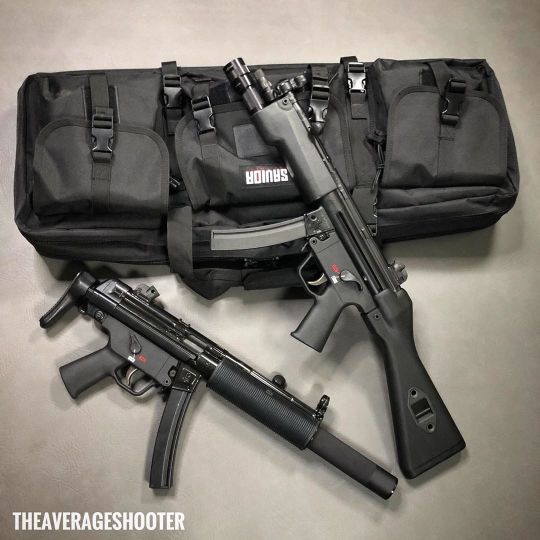
Finally got around to watching Die Hard since everyone with a MP5 seems to rave over it. Honestly, I don’t get the hype. 🤷🏼♂️ . #mp5 #hk #diehard #christmasmovie #mp5a2 #sbr #nfa #80s #nocompromise #hans #john #german #roller #rollerlock #savior #rangebag @weaponsdaily @weaponsfanatics @weaponspromo @gunsdaily @guns.page @guns_fanatics_ @gunfreaks @hkparts @hk_addicts @hkclone @rollerlyfe @hk_rollerlock_addicts (at Fayetteville, North Carolina) https://www.instagram.com/p/B6edSIVJKUQ/?igshid=18gbo1l2k1wcw
#mp5#hk#diehard#christmasmovie#mp5a2#sbr#nfa#80s#nocompromise#hans#john#german#roller#rollerlock#savior#rangebag
26 notes
·
View notes
Video
See on IG: http://ift.tt/2zuhM9l - Rate of fire = sex 🔥 Via @guns.gold - What a nifty little machine gun. I love the rate of fire on this thing. #sten #9mm #slingersclub . @mr.gun.official @fullautofriday @hyperiousx @loucosporarmas @badassfirearms @endlessboxcom @gunsdaily . . . . . #mp5 #mp5a2 #mp5a3 #nfa #nfaaf #gun #guns #rifle #fullauto #fullyautomatic #pewpew #pewpewlife #2a #secondamendment #dailyguns #dailygundose #igmilitia
9 notes
·
View notes
Text
About Sandman
Sandman
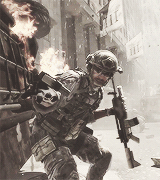
Name: ███ ██████
Codename: Sandman.
Call-sign: Metal Zero One [M01].
DOB: 10/10/69.
Eyes: Blue-gray
Hair: Blonde.
Blood: O POS.
Height: 6'1" [185cm].
Distinguishing marks: “what the thunder said” tattooed high across shoulder blades.
Weight: 190 lbs.
Country: United States.
Place of Birth: Atlanta, Georgia.
Unit: United States Special Forces Operational Detatchment-Delta [SFOD-D] A Squadron; “Delta Force”.
Training Program: Graduate of both United States Army Ranger School and JSOC’s 6-month Operator Training Course [OTC], including SERE [Survival, Evasion, Resistance and Escape], marksmanship, demolitions, combined skills, counter-terrorism and hostage-rescue training, assault, sniping, TOC and communications, espionage-related skills such as dead drops, brief encounters, pickups, load and unload signals, danger and safe signals, surveillance and countersurveillance, executive protection [HVI bodyguard duties], advanced driving [including on-road, off-road, defensive, rally, and protective security], combat medicine, and Advanced Special Operations. He is also a qualified interrogator and Unmanned Aerial Vehicle [UAV] operator.
Languages Spoken: English, French, German, Pashto, Somali, Russian.
Rank: Master Sergeant.
PFT Score: 293.
Rifle Qual. Score: 305.
Loadout: M4A1, M16A4, Heckler & Koch MP5A2, Remington ACR 6.8, SCAR-L, FN Five-seveN, Remington Semi-Automatic Sniper System (RSASS), combat knife.
Disciplinary History: Clean.
Operational History: Applied to join United States Army at age 17; was noted to have scored “exceptionally well” on Armed Services Vocational Aptitude Battery (ASVAB) and noted by superiors to have “good moral character” with one officer citing him as a “Hero waiting to happen”.
Enlisted in 101st Airborne Division at age 18, and after serving for three years applied for US Army Ranger selection. Graduated Ranger school after intensive 61-day training course and deployed to Panama during Operation Just Cause with 75th Ranger Regiment. First combat operation involved dropping into Omar Torrijos Airport to seize runway from Panamanian Defense Force (PDF), and was later promoted to Sergeant after his involvement in the successful capture of the city of Davíd.
Personnel file was flagged by JSOC for potential suitability for SF selection, and was subsequently recommended for Delta Force selection at the age of 21 after participating in Operation Desert Storm whilst still attached to 75RGR. Passed 6-month selection course in 1990. First operation whilst assigned to Delta was Operation Desert Storm, which involved supporting regular army units that were providing close protection detail for General Norman Schwarzkopf in Saudi Arabia.
Was later tasked with hunting for SCUD missiles alongside other coalition special forces, principally the British Army’s 22nd Special Air Service Regiment; it is worth noting that during this time he personally accompanied then Lieutenant John Price on several covert operations.
Deployed to Mogadishu, Somalia as part of Task Force Ranger in preparation for Operation Gothic Serpent and was tasked with securing several of General Mohammed Farah Aidid’s top lieutenants, as well as a few other targets of high value. Took part in the Battle of Mogadishu and was commended for bravery for his actions during this operation; received the Bronze Star with Valor Device, the United States military’s fourth highest award for valor, and is believed to be personally responsible for the deaths of up to 30 Somalis as he led the main ground force to the crash site of CW3 Cliff “Elvis” Wolcott and CW3 Donovan Briley, and later during the Task Force’s extraction via the “Mogadishu Mile”.
Was involved in Operation Uphold Democracy in 1994, and was sent to Lima, Peru immediately following the takeover of the Japanese Ambassador’s residence for counter-terrorism training purposes alongside SAS operators including John Price. In 1999, shortly after his promotion to the rank of Master Sergeant, he was tasked with preparing security for the Seattle WTO Conference, specifically against a chemical weapon attack, and spent the next few years at Fort Bragg as a training instructor until Operation Enduring Freedom in 2001.
During this time he took part in operations against the Taliban whilst assigned to Task Force 121 as part of TF-Green detachment, tasked with the apprehension of High Value Target (HVT) individuals like Osama Bin Laden and other key al-Qaeda and Taliban leadership figures. He participated in Operation Rhino and Operation Anaconda, serving alongside SAS forces led by Captain John Price during the latter.
During his time on Task Force 121 [variously named as Task Force Sword, Task Force 11, Task Force 20, Task Force 121, Task Force 145 and Task Force 6-26 for OPSEC purposes] he helped friendly forces kill or capture more than 2,000 enemy insurgents. Upon being reassigned to Afghanistan, he was attached to a USMC company for the duration of Operation Phantom Fury as a sniper; during this time he collaborated with Delta Force operators “Truck” and “Grinch”, who would later be assigned to Fireteam Metal, which Sandman was given OPCON of just prior to the Siege of Mosul in April 2004.
Metal was later involved in the hunt for and eventual capture of Saddam Hussein, and surveilling a compound where Jordanian militant Islamist Abu Musab al-Zarqawi had been staying, eventually calling in the airstrike that killed him. On 8 June 2004, elements of A Squadron, including then-Corporal Derek “Frost” Westbrook, along with Army’s 160th Special Operations Aviation Regiment [160th SOAR - “Night Stalkers”] carried out a raid to save foreign workers at a compound near Ramadi. The kidnappers were caught off-guard and surrendered immediately; the mission was a complete success.
Westbrook subsequently recieved a promotion to Sergeant and was assigned to Metal under the call-sign “Frost”.
Deployed to the Horn of Africa from 20██ onwards; participated in Operation Enduring Freedom – Horn of Africa [OEF-HOA], and conducted operations against elements of the AQT [Al-Qaeda and Taliban] insurgency in Combined Joint Task Force – Horn of Africa [CJTF-HOA]’s areas of responsibility, including but not limited to counter-insurgency operations in Sudan, Somalia, Djibouti, Ethiopia, Seychelles, Kenya, Liberia, Rwanda, Uganda and Tanzania.
Did not directly take part in the US invasion of the Middle East in 2011, nor the subsequent operations conducted by the joint SAS/MARSOC Task Force in Russia, but was extensively involved in neutralising insurgent elements shortly after the OpFor invasion of Afghanistan. Participated in Operation KINGFISH alongside Task Force 141 operators John “Soap” MacTavish, Simon “Ghost” Riley, Gary “Roach” Sanderson, Delta operators from Fireteam Metal and Captain John Price, who is believed to be dead after an operation in the Karkonosze Mountains in the Ukraine [see notes in attached file: FIND_MAKAROV//OPERATION_KINGFISH for further information].
Operations in the Middle East are ongoing as of 2013 and are being funded by the CIA with support from their Special Activities Division, currently concerned with the apprehension and/or neutralisation of international terrorist Vladimir Makarov under the jurisdiction of JSOC [see notes in attached file: KINGFISH for further information].
Tag: getswitchedon
0 notes




